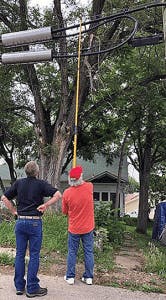
It’s Time to Surrender Your Breakdown Set —
When we stop getting questions about paper/pulp insulated cables, we will stop writing about them. The truth is that there are still millions of subscribers working through these sealed plant designs. These cables still get wet, and we still must find and fix the faults.
This article explores the reasons why we continue to battle problems associated with troubleshooting paper/pulp insulated cables.
Figure 1. Using a receiver coil to detect fault locating tone.
To begin, it’s important to remember that this type of copper network with paper/pulp insulated cable is sealed. Therefore, fault isolation is difficult because we are unable to "divide and conquer" efficiently. Tone-based fault locating has been the traditional method for decades. (See Figure 1.)
The concept for fault locating using a breakdown set could not be simpler: the tone is connected to a bad cable pair and it stops at the fault. If the fault is 0-Ohm (metal to metal) and no other path to ground is present, then you simply find where the tone stops and open the cable there.
The first problem is that wet pulp insulation rarely offers 0-ohm faults. Even the slightest resistance at the fault can cause the tone to carry by, and then even the most experienced cable technicians can chase their tails for hours.
This problem was traditionally solved by "breaking down" a fault using approximately 500 VDC at a few amps to weld the fault together to create a 0-ohm fault.
The Most Ignored Safety Procedure Ever
You may be thinking 500 volts at a few amps sounds dangerous, and you are right. It is incredibly painful; and if you are grounded just right, it could stop your heart. This has always been understood, so a safety procedure was created very early in the process.
InvisiLight® Solution for Deploying Fiber
April 2, 2022Go to Market Faster. Speed up Network Deployment
April 2, 2022Episode 10: Fiber Optic Closure Specs Explained…
April 1, 2022Food for Thought from Our 2022 ICT Visionaries
April 1, 2022According to an old procedure instituted in the 1940s, a sign was to be placed in every terminal where the cable pair appears: Warning! High Voltage Test in Progress! That might not sound like a big deal, but party lines were normal at that time, so the pairs appeared in several terminals.
What’s more, they were all aerial, and there were no bucket trucks. So, you were supposed to climb 8 or 9 poles to insert a sign warning your co-workers of the danger. Only then could you use the breakdown set. When you found the wet cable, you went about solving the problem by opening the sheath, drying the pulp and then closing the sheath. THEN, you had to go back, climb all those poles again, and remove the signs. You can imagine how many times that procedure was followed.
The Tone Arc was the next generation of the breakdown set, using higher voltage and much lower amperage. The same safety procedures were required, and they were equally ignored.
The Replacements
At some point in the 1980s, it was determined that the potential damage caused by the breakdown sets overwhelmed the potential benefit. After 40 years, it was determined that:
1. The breakdown sets melted down electronic components. Loop electronics were just being introduced, and many expensive cards were ruined.
2. Even though the drops were supposed to be removed at the terminal, this was not always done.
3. Unknown left-in drops increased the chances of damage and danger.
4. Too many lazy people tried to breakdown faults in PIC cable.
5. A voltage arc behind the wall of an old, dry house has burned down more than one house.
The Tone Arc was a workable replacement for the breakdown set. It sent tone over a temporary 0-ohm fault caused by the arc. The arc was due to high voltage and low amperage finding the weak point in the insulation and arcing there.
I have found hundreds of faults using the Tone Arc, and have found some that I could not have found any other way. Still, the tool yielded inconsistent results. Sometimes, it could nail a 100K-Ohm fault. Other times, it could blow by a 300-Ohm fault. The nature of the fault was as important as the resistance.
In the end, the performance did not matter. The high voltage pulse that did not have impact on POTS killed DSL service. Subscribers that are not impacted by the wet cable were devastated by the Tone Arc pulse. Without the pulse, the Tone Arc lost its arc. It should also be pointed out that the Tone Arc was dangerous to people and equipment; just not as dangerous as the breakdown set.
The Tone Ranger was the next tool we used to troubleshoot paper/pulp insulated cables. This tool was a Tone Arc without the arc. It did much more than the breakdown set, including detecting open shield. However, without a 0-Ohm fault, some tone blew by. Using this tool, the technician had to determine tone level/distortion with variable frequencies and gains available. Technicians using this tool found that troubleshooting with it was more art than it was science.
The Problem Continues
That leads us to a letter I received recently from a network operations manager for a large service provider. Read it and find out how they are STILL trying to find a better solution – some 60 years after paper/pulp insulated cables were no longer the go-to in the field.
Dear Vernon,
We have very few breakdown sets and burndown transformers still in use out here, (which is good since we banned them from use in early 1991 or 1992). They’re going by the wayside as expected.
Unfortunately, we still need an effective solution to address our testing needs on paper/pulp plant. So, my co-worker and I decided to jump in to see what we could come up with — alongside a trustworthy vendor partner.
Through many instances of trialing and missing the mark and sending the vendor back to the drawing board to improve upon and enhance the capabilities of the instrument, we believe we have a product that will improve troubleshooting if given a fair shake by the technicians who refuse to surrender of their breakdown sets.
We created a product that we believe gives us an advantage in troubleshooting paper insulated cable pairs compared with RFL or TDR instruments. Our hope is this alternative solution will quickly be able to nail the trouble spot where ready access points are limited.
Beyond the trials we’ve conducted and the minimal number of technicians we’ve had involved in the trials, we are interested in additional expertise and validation. Your insight would be very much appreciated.
We’re not looking for anyone to tell us this is a good alternative if they believe it is not. In addition, we are open to people poking it with sticks and calling out its deficits while keeping in mind that no one instrument does it all and each individual instrument has its limitations.
The last thing we want to do is roll something out to the field that doesn’t give us a realistic solution over the use of RFL and TDR equipment in sectionalizing, isolating and repairing trouble in aerial stalpeth and alpeth cables.
Thank you in advance for any input you may have.
A Network Operations Manager
Like this Article?
Subscribe to ISE magazine and start receiving your FREE monthly copy today!
More to Come
I couldn’t help but take on the challenge of going out to the field with this operations manager and explore this tool his team and a vendor partner created. The report of my findings will be published in next month’s edition of ISE magazine.
About the Author

Vernon May
Vernon May is the Chief Technologist and Founder of Vernon May Solutions. He is an expert in OSP and ISP Operations, and focuses on new technology introduction, from marketing and sales to design enhancement to training to product approval. Along with writing a column for ISE magazine, he also hosts seminars available throughout the country.
For more information, call Vernon at 1.319.238.0285, email: [email protected], visit https://www.vmaysolutions.com/, and follow him on Twitter @Vernonmay13.




